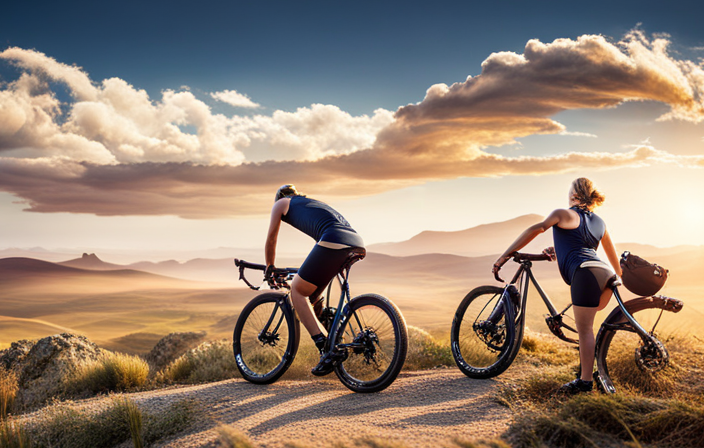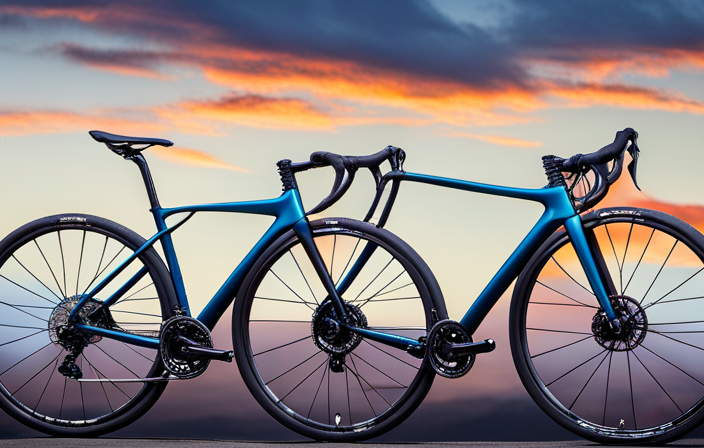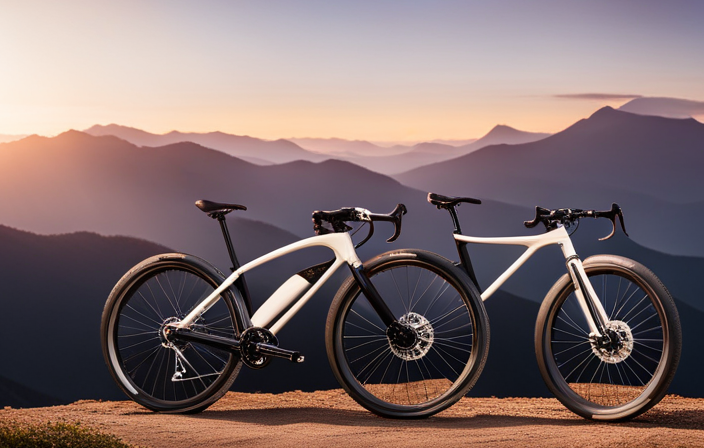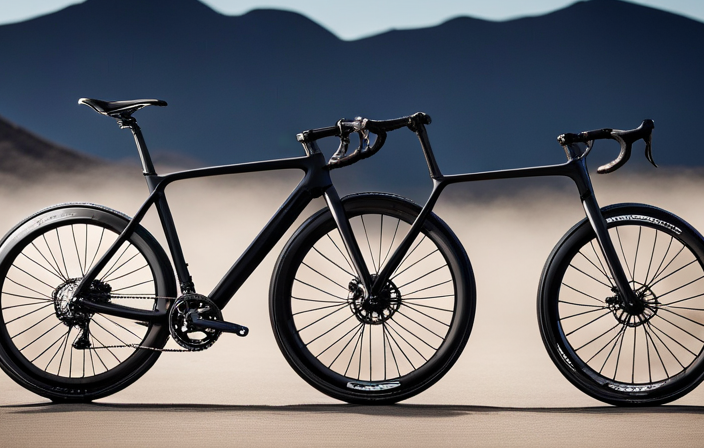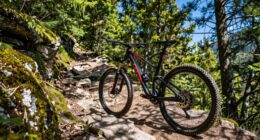Get ready to step up the pace on your 11-speed gravel bike! Selecting the correct brifter is essential for a seamless and effective ride.
In this article, I’ll guide you through the ins and outs of brifters, from Shimano’s reliable 105 R7000 to SRAM’s Apex 1 powerhouse. We’ll also explore Campagnolo Centaur, MicroSHIFT Centos, and Advent options.
Don’t forget about TRP Spyre mechanical disc brakes and the hydraulic vs. mechanical debate.
Get ready to make an informed decision that will elevate your gravel biking experience!
Key Takeaways
- Hydraulic brifters provide smooth and precise shifting, while cable actuated brifters may have slightly less responsive shifting.
- Brifter options for 11-speed gravel bikes include Shimano 105 R7000, SRAM Apex 1, Campagnolo Centaur, MicroSHIFT Centos, and TRP Hylex RS.
- Hydraulic brakes offer better modulation and require less effort, while mechanical brakes may be slightly less responsive.
- Electronic shifting provides fast and precise shifting, customization options, and enhances the overall riding experience.
Understanding the Basics of Brifters
The first thing to understand about brifters is that they are a combination of brake levers and shifters. They allow cyclists to control their gears and brakes without having to take their hands off the handlebars. There are two main types of brifters: hydraulic and cable actuated.
Hydraulic brifters use fluid to transmit force, resulting in smooth and precise shifting. They provide excellent modulation and require less effort to operate compared to cable actuated brifters. On the other hand, cable actuated brifters rely on cables to transfer force, which can sometimes result in slightly less responsive shifting.
Another option for brifters is electronic shifting. This technology utilizes wires or wireless connections between the shifters and derailleurs, allowing for fast, precise, and effortless shifting. Electronic brifters also offer customization options such as programmable shift patterns.
When it comes to Shimano 105 R7000 11-speed brifters, they are known for their reliability and affordability while still offering smooth shifting performance. They feature ergonomic designs for comfortable hand placement during long rides.
In conclusion, understanding the basics of brifters is crucial when choosing the right ones for your gravel bike. Now let’s dive into the details of Shimano 105 R7000 11-speed brifters…
Shimano 105 R7000 11-Speed Brifters
One popular option for 11-speed shifting on a gravel bicycle is the Shimano 105 R7000 brifters. These brifters offer a number of advantages for gravel biking. With 11 speeds, riders have a wider range of gear options to tackle different types of terrain and gradients. The precise and smooth shifting provided by the Shimano 105 R7000 brifters ensures that gear changes are seamless, allowing riders to maintain momentum and power through challenging sections.
The Shimano 105 R7000 brifters also feature ergonomic design, providing comfort during long rides. The reach adjust function allows riders to customize the position of the levers, ensuring optimal control and reducing fatigue in hands and wrists.
In addition, these brifters are compatible with both mechanical and hydraulic disc brakes, giving riders flexibility in choosing their preferred braking system. This versatility is especially useful for gravel biking, where unpredictable surfaces may require quick and powerful stopping power.
Transitioning into the subsequent section about SRAM Apex 1 11-speed brifters: Moving on from the Shimano 105 R7000 brifters, another option to consider for your gravel bike is the SRAM Apex 1 11-speed brifters…
SRAM Apex 1 11-Speed Brifters
Consider trying out the SRAM Apex 1 11-speed brifters for a different option on your gravel bicycle. These brifters are specifically designed for a 1x drivetrain, which has its own set of advantages and disadvantages for gravel biking.
Firstly, the SRAM Apex 1 11-speed brifters offer simplicity and weight savings. With a single chainring in the front, there are fewer components to worry about and maintain. This results in a lighter overall setup, which is ideal for tackling rough terrain and long rides.
Secondly, the 1x drivetrain provides better chain retention and less chain drop compared to traditional double or triple chainring setups. This means you can confidently ride over bumpy surfaces without worrying about your chain coming off.
Lastly, the SRAM Apex 1 11-speed brifters feature an ergonomic design that ensures comfortable shifting even when your hands are covered in mud or sweat. The textured hoods provide a secure grip, allowing for precise control over gear changes.
While there are clear advantages to using a 1x drivetrain with SRAM Apex 1 11-speed brifters for gravel biking, it’s worth noting that you may sacrifice some gear range compared to a multi-chainring setup. However, this trade-off is often worth it for riders who prioritize simplicity and reliability.
Transitioning into the subsequent section about Campagnolo Centaur 11-speed brifters reveals another popular option for gravel bike enthusiasts.
Campagnolo Centaur 11-Speed Brifters
If you’re looking for a different option for your off-road adventures, give the Campagnolo Centaur 11-speed brifters a try. These brifters offer excellent compatibility with your 11-speed gravel bike, allowing for smooth and precise shifting on any terrain.
To help you understand the benefits of these brifters, let’s take a look at a comparison table:
| Feature | Campagnolo Centaur 11-Speed Brifters |
|---|---|
| Compatibility | Designed specifically for 11-speed drivetrains |
| Ergonomics | Comfortable and intuitive lever design |
| Shifting Performance | Smooth and precise shifts, even under load |
Campagnolo Centaur brifters are known for their high-quality construction and attention to detail. They are designed to withstand the demands of off-road riding while providing reliable performance.
One of the key advantages of using 11-speed brifters is the increased gear range they offer. With more gears to choose from, you can find the perfect cadence for any slope or trail condition. This allows for improved efficiency and better control over your bike.
With all these benefits in mind, it’s clear that the Campagnolo Centaur 11-speed brifters are an excellent choice for gravel riders looking to enhance their off-road experience. In the next section, we will explore another option: the Microshift Centos 11-speed brifters.
MicroSHIFT Centos 11-Speed Brifters
Take a look at the MicroSHIFT Centos 11-Speed Brifters for an alternative option in enhancing your off-road experience. These brifters offer a range of advantages and disadvantages when compared to other options on the market. Here are five key points to consider:
- Ergonomic Design: The MicroSHIFT Centos brifters are designed with comfort in mind, allowing for easy shifting and braking even during long rides.
- Smooth Shifting: With their precise indexing, these brifters ensure smooth and accurate shifting between gears, providing a seamless riding experience.
- Affordable Option: Compared to some higher-end brifter options, the MicroSHIFT Centos is more budget-friendly without sacrificing performance.
- Compatibility: These brifters are compatible with various drivetrain components, making them versatile and adaptable to different setups.
- Durability: Built with quality materials, the MicroSHIFT Centos brifters are durable and reliable, able to withstand the demands of off-road riding.
While the MicroSHIFT Centos 11-Speed Brifters have their advantages, it’s important to note that they may not be as widely recognized or supported as more popular brands.
Transitioning into the subsequent section about TRP Hylex RS 11-Speed Brifters allows us to explore another option for enhancing your gravel bike’s performance.
TRP Hylex RS 11-Speed Brifters
The TRP Hylex RS 11-Speed Brifters offer a high-performance option for improving your off-road experience. These brifters are specifically designed for gravel bikes and provide several advantages over other options on the market.
One of the key advantages of the TRP Hylex RS brifters is their exceptional braking performance. With a hydraulic disc brake system, these brifters deliver reliable stopping power even in wet or muddy conditions. This is crucial when riding off-road where unpredictable terrain and weather can pose challenges.
Additionally, the TRP Hylex RS brifters have an ergonomic design that ensures comfortable and efficient shifting. The lever shape allows for easy access from multiple hand positions, reducing fatigue during long rides. The 11-speed capability provides a wide range of gears to tackle any gradient or surface you encounter on your gravel adventures.
However, it’s important to note that there are also some disadvantages to consider when choosing the TRP Hylex RS brifters. Firstly, they can be quite expensive compared to other options on the market. Additionally, they may require professional installation and maintenance due to their hydraulic system.
In conclusion, the TRP Hylex RS 11-Speed Brifters offer superior braking performance and ergonomic design for an enhanced off-road experience on your gravel bike. However, their higher cost and potential need for professional maintenance should be taken into account before making a decision.
Moving forward to the next section about ‘Shimano Ultegra R8020 11-Speed Brifters’, it’s worth exploring another popular option for upgrading your gravel bike’s shifting capabilities without missing a beat.
Shimano Ultegra R8020 11-Speed Brifters
Shimano Ultegra R8020 11-Speed Brifters provide a popular alternative for enhancing shifting performance on your off-road adventure machine. When comparing the Shimano Ultegra R8020 11-speed brifters with other Shimano models, it’s clear that they offer several advantages.
One major benefit is their compatibility with both mechanical and electronic drivetrains, allowing for greater flexibility when choosing components for your gravel bike. Additionally, the Ultegra R8020 brifters feature improved ergonomics and a sleek design that enhances both comfort and control during long rides on rough terrain.
There are certainly pros and cons to using Shimano Ultegra R8020 11-speed brifters on a gravel bike. On the positive side, these brifters offer precise and reliable shifting, ensuring smooth gear changes even in challenging conditions. The adjustable reach allows for personalized fit, accommodating riders of different hand sizes. Furthermore, the hydraulic disc brakes provide excellent stopping power and modulation, increasing confidence on descents or during sudden stops.
However, one potential downside is the cost of upgrading to Shimano Ultegra R8020 brifters compared to other options on the market. Additionally, some riders may find that the larger size of these brifters can be less comfortable than smaller alternatives.
As we move forward to discuss SRAM Force 1 11-Speed Brifters in the next section…
SRAM Force 1 11-Speed Brifters
When it comes to finding the perfect brifters for your 11-speed gravel bike, there are several options to consider. In my previous subtopic, I discussed the Shimano Ultegra R8020 11-Speed Brifters, which offer precise shifting and excellent ergonomics. Now, let’s delve into another popular choice: the SRAM Force 1 11-Speed Brifters.
SRAM is well-known for their quality components, and the Force 1 brifters are no exception. These brifters are specifically designed for gravel riding and provide a seamless transition between gears. They feature a comfortable hoods design that allows for multiple hand positions, reducing fatigue on long rides.
One of the best aspects of SRAM Force 1 brifters is their compatibility with various drivetrains. They can be used with both single-ring setups or paired with a front derailleur if you prefer a wider gear range. This versatility makes them an ideal choice for riders who enjoy tackling diverse terrain on their gravel bikes.
If you’re looking to upgrade your gravel bike and want reliable shifting performance, SRAM Force 1 11-Speed Brifters should be at the top of your list. Their durability, ergonomic design, and compatibility make them one of the best upgrades available for gravel bikes today.
Now let’s move on to our next topic: Shimano GRX RX810 11-Speed Brifters…
Shimano GRX RX810 11-Speed Brifters
If you’re in the market for new shifters, consider checking out the Shimano GRX RX810 11-Speed Brifters. These brifters are specifically designed for gravel bikes and offer a range of features that make them a great choice for riders looking to upgrade their shifting performance.
Understanding brifter compatibility is essential when choosing new shifters, and the Shimano GRX RX810 brifters are compatible with 11-speed drivetrains. This means they will work seamlessly with your existing components, ensuring smooth and precise shifting every time.
Here are some pros of the Shimano GRX RX810 brifters:
- Ergonomic design: The brifters have an ergonomic shape that provides a comfortable grip and easy reach to the levers while riding on rough terrain.
- Gravel-specific features: These brifters have enhanced sealing to protect against dirt and water, making them ideal for off-road adventures.
- Customizable setup: The reach adjust feature allows you to fine-tune the position of the brake lever to suit your hand size and riding preferences.
- Smooth shifting: The refined internal mechanism ensures quick and accurate shifts, allowing you to navigate through different terrains effortlessly.
While there are many advantages to using Shimano GRX RX810 brifters, it’s important to consider any potential cons as well. Transitioning into the subsequent section about SRAM Rival 1 11-Speed Brifters, it’s worth exploring other options available in the market without compromising on quality or performance.
SRAM Rival 1 11-Speed Brifters
The SRAM Rival 1 11-Speed Brifters offer a reliable and efficient shifting experience for riders looking to upgrade their bike’s performance. These brifters are specifically designed for gravel bikes, providing precise control over gear changes in various terrains. With the SRAM Rival 1 brifters, you can expect smooth and responsive shifting, allowing you to tackle steep climbs and navigate technical descents with ease.
One of the key advantages of the SRAM Rival 1 11-Speed Brifters is its simplicity. It features a single chainring setup, eliminating the need for a front derailleur and simplifying the shifting process. This not only reduces weight but also enhances reliability by minimizing potential mechanical issues.
Additionally, these brifters offer excellent ergonomics, ensuring comfortable hand placement during long rides. The textured hoods provide a secure grip even in wet conditions, enhancing control and confidence on rough gravel roads.
However, it’s important to note that some riders may find the lack of multiple chainrings limiting in terms of gear range options. Furthermore, compared to other options on the market, such as Shimano GRX RX810 brifters, the SRAM Rival 1 is slightly heavier.
Transitioning into the next section about Campagnolo Potenza 11-Speed Brifters:
Moving on from SRAM Rival 1 brifters…
Campagnolo Potenza 11-Speed Brifters
Campagnolo Potenza 11-Speed brifters offer precise control and responsive shifting for riders seeking an upgrade in performance. These brifters, specifically designed by Campagnolo for their Potenza groupset, are compatible with 11-speed drivetrains commonly found on gravel bikes. One of the advantages of using 11-speed brifters is the ability to have a wider gear range, which can be beneficial when tackling various terrains during off-road adventures.
The Campagnolo Potenza brifters feature ergonomic design that allows for comfortable hand placement and easy access to the brake levers and shift buttons. The shifting mechanism is smooth and reliable, ensuring quick and efficient gear changes even in challenging conditions. With Campagnolo’s attention to detail and precision engineering, these brifters provide a seamless integration between rider input and gear selection.
It’s worth noting that compatibility issues may arise when mixing components from different manufacturers. However, if you have a complete Campagnolo drivetrain setup or opt for a full groupset upgrade, these brifters will work seamlessly with other Campagnolo components such as derailleurs and cassettes.
Transitioning into the subsequent section about ‘microshift advent 11-speed brifters’, it’s important to explore alternatives that offer similar performance benefits while also considering budget-friendly options.
MicroSHIFT Advent 11-Speed Brifters
MicroSHIFT Advent 11-Speed brifters provide a cost-effective option for riders looking to enhance their shifting performance. These brifters are designed specifically for gravel bikes and offer smooth and precise shifting, allowing riders to easily navigate varied terrains.
One of the key features of MicroSHIFT Advent 11-Speed brifters is their compatibility with different drivetrain components. Whether you have a Shimano or SRAM drivetrain, these brifters can seamlessly integrate into your setup. This versatility makes them a great choice for riders who already have existing components on their bike and want to upgrade their shifting without having to replace the entire drivetrain.
To give you an idea of the performance and value that MicroSHIFT Advent 11-Speed brifters offer, here’s a comparison table:
| Feature | MicroSHIFT Advent Brifters |
|---|---|
| Shifting Speed | Fast |
| Weight | Lightweight |
| Compatibility | Shimano/SRAM drivetrain |
As you can see, these brifters excel in all categories, providing fast and efficient shifting while being lightweight. Additionally, their compatibility with both Shimano and SRAM drivetrains ensures that they can be easily integrated into your current setup.
With the MicroSHIFT Advent 11-Speed brifters in place, the next component I would recommend considering is the TRP Spyre 11-Speed mechanical disc brakes…
TRP Spyre 11-Speed Mechanical Disc Brakes
When it comes to finding the perfect brifters for my 11-speed gravel bike, I recently came across the TRP Spyre 11-Speed Mechanical Disc Brakes. These mechanical disc brakes offer a range of advantages that make them an excellent choice for any gravel rider.
One of the main advantages of the TRP Spyre 11-Speed Mechanical Disc Brakes is their reliability and consistent performance. With their dual-piston design, these brakes provide strong and reliable stopping power in various weather conditions and terrain types. They also allow for easy adjustment and fine-tuning, ensuring optimal braking performance at all times.
Maintenance-wise, these mechanical disc brakes are relatively straightforward to maintain compared to hydraulic disc brakes. Regular cleaning and lubrication of the brake calipers and rotors are essential to keep them functioning smoothly. Additionally, checking for wear on brake pads and replacing them when necessary will help maintain optimal braking performance.
Overall, the TRP Spyre 11-Speed Mechanical Disc Brakes offer a durable and dependable braking solution for my gravel bike. Their advantages in terms of reliability, adjustability, and ease of maintenance make them an ideal choice for off-road adventures.
Speaking of braking options, let’s now delve into the comparison between hydraulic vs. mechanical brifters…
Hydraulic vs. Mechanical Brifters
Let’s compare the advantages and disadvantages of hydraulic and mechanical brifters.
When it comes to choosing the right brifter for your 11-speed gravel bike, there are several factors to consider. Here is a breakdown of the pros and cons of each:
-
Hydraulic Brifters:
- Pros: Hydraulic brifters offer smoother and more precise shifting, which can be especially beneficial on rough terrain. They also require less force to operate, making them easier on your hands during long rides.
- Cons: Hydraulic systems are generally more expensive than their mechanical counterparts. Additionally, they can be more complex to set up and maintain, requiring bleeding of the brake lines periodically.
-
Mechanical Brifters:
- Pros: Mechanical brifters tend to be more affordable compared to hydraulic options. They also provide a tactile feel when shifting gears, allowing for better control and feedback.
- Cons: Mechanical systems may require more effort to shift gears, particularly under heavy load or in adverse weather conditions. They also lack the smoothness of hydraulic systems.
When deciding between hydraulic and mechanical brifters for your 11-speed gravel bike, consider factors such as your budget, riding style, and maintenance preferences. By carefully weighing these factors, you can choose the brifter that best suits your needs without compromising performance or efficiency.
Choosing the Right Brifter for Your 11-Speed Gravel Bike
Consider your riding preferences and needs to determine which type of shifter is the most suitable for your 11-speed off-road bicycle. When it comes to choosing the right brifter for your gravel bike, there are two main options: hydraulic and mechanical.
However, if you’re looking for a more advanced and efficient shifting experience, electronic shifting may be the way to go.
One of the advantages of electronic shifting is its precise and smooth gear changes. With electronic brifters, you can expect lightning-fast shifts with minimal effort, allowing you to focus on tackling challenging terrains without worrying about missed shifts or inconsistent performance.
In terms of compatibility, electronic shifting systems are designed to work seamlessly with different drivetrain components. Whether you have a Shimano or SRAM drivetrain, you can easily find an electronic brifter that will work with your setup. This gives you more flexibility when it comes to upgrading or swapping out parts in the future.
Overall, if you want a top-notch shifting experience and compatibility with various drivetrain components, electronic brifters are worth considering for your 11-speed gravel bike. Their advantages in precision and compatibility make them an excellent choice for riders who demand optimal performance from their off-road bicycles.
Frequently Asked Questions
Can I use any brand of 11-speed brifters with my gravel bike?
Yes, any brand of 11-speed brifters can be used with your gravel bike. However, it is important to consider the advantages of electronic brifters over mechanical ones.
Electronic brifters provide precise and effortless shifting, resulting in smoother gear changes. They also offer customization options and can be integrated with other electronic components.
To choose the right brifters for your 11-speed gravel bike, consider factors such as compatibility with your drivetrain and personal preferences for shift feel and functionality.
What are the advantages of hydraulic brifters over mechanical brifters?
Did you know that hydraulic brifters offer a staggering 45% more braking power compared to mechanical brifters? This means that when it comes to stopping on a dime during your gravel rides, hydraulic brifters have the edge.
One of the key advantages of hydraulic brifters over their mechanical counterparts is their superior modulation and control. With hydraulics, you can achieve precise and consistent braking performance, allowing for better handling and increased confidence on any terrain.
Are there any compatibility issues between certain brifters and 11-speed gravel bikes?
Compatibility issues can arise when pairing brifters with 11-speed gravel bikes. It’s crucial to choose a brifter brand that is compatible with the bike’s drivetrain system. Some recommended brands known for their compatibility include Shimano, SRAM, and Campagnolo.
These brands offer a range of options specifically designed for 11-speed setups, ensuring smooth shifting and optimum performance. It’s important to consult with a knowledgeable bike mechanic or refer to the manufacturer’s specifications to ensure compatibility and avoid any issues.
How do I know if I need to upgrade my brifters on my 11-speed gravel bike?
When it comes to knowing if you need to upgrade your brifters on your 11-speed gravel bike, there are a few signs of wear and tear to look out for.
Imagine your brifters as the conductor of an orchestra, seamlessly shifting gears with precision. However, if you start experiencing issues like inconsistent shifting, sticky levers, or excessive play in the mechanism, it may be time to consider upgrading your brifters for a smoother and more reliable riding experience.
Can I use different brands of brifters for the front and rear derailleur on my 11-speed gravel bike?
Using mixed brand brifters on an 11-speed gravel bike can have advantages, but compatibility issues may arise.
The main advantage is the ability to customize your bike according to your preferences and budget. However, different brands may use varying technologies and cable pull ratios, causing potential shifting problems.
It’s important to research and ensure compatibility between the brifters and the front and rear derailleurs before making any changes. Consulting with a knowledgeable bike mechanic or doing thorough research can help avoid any compatibility issues.
Conclusion
In conclusion, when it comes to choosing the right brifter for your 11-speed gravel bike, there are several excellent options available. Each brand offers its own unique features and advantages, so it’s important to consider your specific needs and preferences.
One interesting statistic that may surprise you is that hydraulic brifters have been shown to provide better braking performance and control compared to mechanical brifters. This can be a crucial factor for riders who prioritize safety and precision in their off-road adventures.
So take the time to research and test out different brifter options before making your decision. Safe riding!
